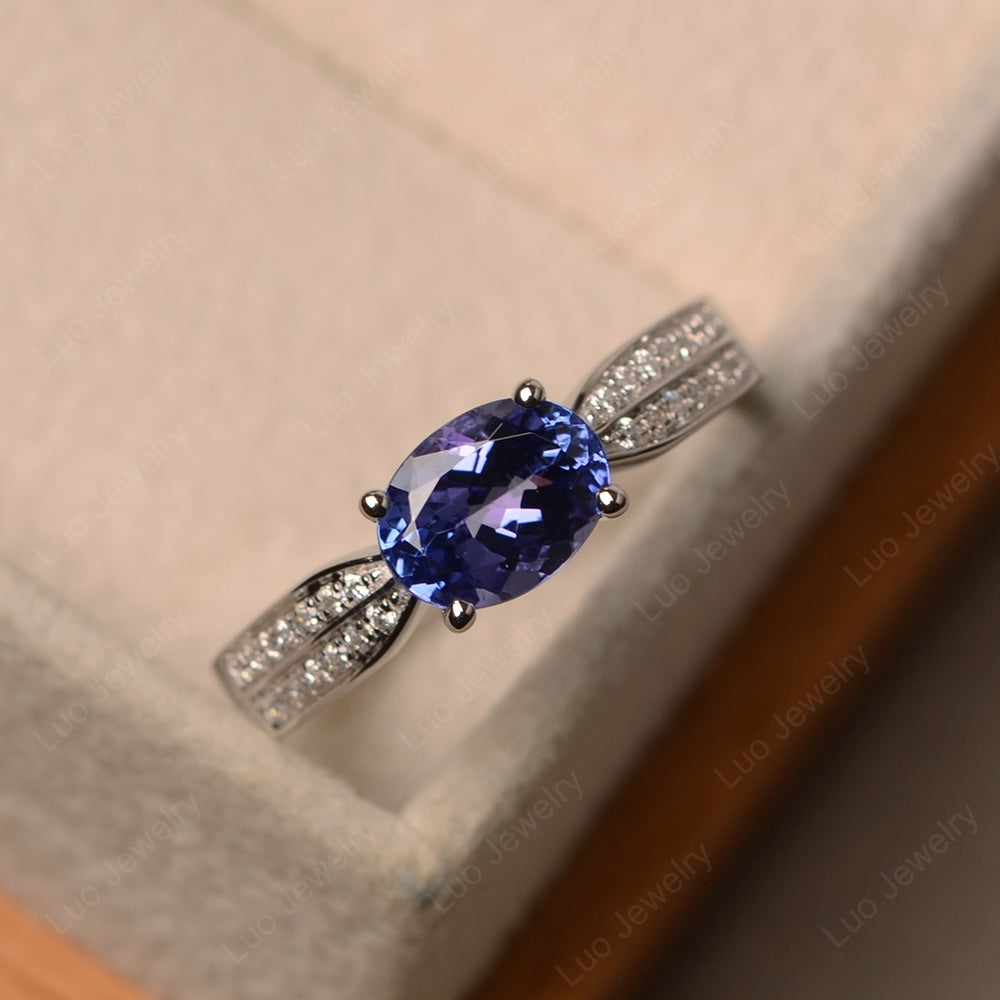 Alexandrite
Alexandrite Amethyst
Amethyst Aquamarine
Aquamarine Black Rutilated Quartz
Black Rutilated Quartz Black Spinel
Black Spinel Cubic Zirconia
Cubic Zirconia Citrine
Citrine Garnet
Garnet Emerald
Emerald Lemon Quartz
Lemon Quartz London Blue Topaz
London Blue Topaz Green Amethyst
Green Amethyst Green Sapphire
Green Sapphire Mystic Topaz
Mystic Topaz Moonstone
Moonstone Moissanite
Moissanite Morganite
Morganite Moss Agate
Moss Agate Opal
Opal Peridot
Peridot Pink Sapphire
Pink Sapphire Rose Quartz
Rose Quartz Ruby
Ruby Sapphire
Sapphire Smoky Quartz
Smoky Quartz Swiss Blue Topaz
Swiss Blue Topaz White Topaz
White Topaz
タンザナイト リング
タンザナイトリングコレクションは、この比類なき宝石の青紫色の輝きを称える逸品です。タンザナイトは、その卓越した彩度と多色性(見る角度によって青みがかったり紫みがかったりする)を厳選し、厳選された宝石を一つ一つ丁寧に選別しています。プラチナとホワイトゴールドのデザインは、クラシックなソリティアから、ヴィンテージ風の精巧なセッティングまで、幅広く取り揃えています。12月の誕生石であるタンザナイトの、唯一無二の美しさを余すところなく表現します。
並び替え
フィルター
Tanzanite Rings | A Radiant Symbol of Transformation, Rarity, and Inner Vision
Tanzanite, one of the rarest gemstones on Earth and the December birthstone alongside blue topaz, is celebrated for its captivating blue-violet hue that shifts with every glance and light source. Discovered only in the foothills of Mount Kilimanjaro in Tanzania, this extraordinary gem embodies the spirit of transformation, enlightenment, and individuality. Its mesmerizing pleochroism—flashing blue, violet, and hints of burgundy—mirrors the complexity and depth of human emotion.
First found in 1967, tanzanite quickly captured the hearts of collectors and jewelry connoisseurs for its ethereal beauty and scarcity—estimated to be over a thousand times rarer than diamond. With a Mohs hardness of 6.5–7, tanzanite is suitable for occasional or mindful daily wear, making it a deeply meaningful choice for engagement rings, milestone celebrations, or December birthday gifts.
At LUO Jewelry, we source each natural tanzanite gemstone for its exceptional color balance and brilliance, ensuring a perfect harmony between its vivid blues and alluring purples. Our designers bring this gem's unique duality to life through thoughtful, modern craftsmanship. Each LUO Jewelry Tanzanite Ring is an ode to individuality—elegant, luminous, and unlike any other.
Our Tanzanite ring collection showcases a variety of distinctive styles, designed to express both timeless sophistication and personal story:
- Halo Tanzanite Engagement Rings: A dazzling halo of diamonds or white sapphires enhances the gem's blue-violet fire, creating a radiant centerpiece that commands attention.
- Three-Stone Tanzanite Engagement Rings: Symbolizing life's past, present, and future, this design highlights tanzanite's transformative energy, flanked by accent stones for added brilliance.
- Bezel-Set Tanzanite Rings: A sleek, protective frame encircles the gemstone, offering modern flair and durability for those who value effortless elegance.
- Solitaire Tanzanite Rings: The ultimate minimalist statement—one vivid stone, one powerful hue—perfect for showcasing tanzanite's natural glow.
- Vintage-Inspired Tanzanite Rings: With intricate filigree and milgrain detailing, these rings evoke romance and old-world charm, celebrating tanzanite's legendary mystique.
- Stackable Tanzanite Rings: Slim, elegant bands featuring petite tanzanites—ideal for layering, mixing metals, and creating a look as unique as you are.
At LUO Jewelry, our master artisans combine precision, passion, and artistry to reveal the full beauty of every tanzanite:
- Precision Cutting: Each tanzanite is meticulously faceted—whether emerald, cushion, or pear—to maximize brilliance and emphasize its chameleon-like color play.
- Secure Hand Setting: Our craftsmen ensure every stone is held safely and beautifully, using prong, tension, or bezel settings that enhance sparkle while ensuring longevity.
- Polishing and Finishing: Each ring is carefully polished to a mirror finish, achieving a silky-smooth surface and a luxurious luster that enhances the gem's enchanting tones.
We also offer custom tanzanite engagement rings, allowing you to select your ideal gemstone, metal, and engraving to create a piece that reflects your love story and individuality.
Discover LUO Jewelry's Tanzanite Ring Collection—where the rare meets the radiant, and every ring tells a story of transformation, depth, and divine light.
Frequently Asked Questions
What is Tanzanite?
Tanzanite is a blue-to-violet variety of the mineral zoisite, discovered in 1967 in Tanzania. It's one of the newest gemstones on the market and was named by Tiffany & Co. after its country of origin. Tanzanite is prized for its remarkable color-changing properties and exceptional brilliance, making it a popular choice for fine jewelry, especially rings.
What Color is Tanzanite?
Tanzanite displays a striking blue-to-violet color range, often described as velvety blue or violet-blue. The stone exhibits pleochroism, meaning it shows different colors when viewed from different angles—typically blue, violet, and burgundy. The most valued tanzanites show a deep, saturated blue with violet undertones. The stone can also appear more violet or purple depending on the lighting conditions, appearing more blue in natural daylight and more violet under incandescent light.
How Does Tanzanite Form?
Tanzanite forms through a rare combination of geological events. It's created when vanadium-rich zoisite is subjected to extreme heat and pressure deep within the Earth's crust, specifically in metamorphic rocks. The unique blue-violet color develops when the mineral is exposed to temperatures around 600°C (1112°F). Natural heat from geological processes or deliberate heat treatment after mining enhances the blue color, as rough tanzanite often appears brownish and requires heating to reveal its signature blue-violet hues.
Where is Tanzanite Found?
Tanzanite is found exclusively in a small mining area near Mount Kilimanjaro in northern Tanzania, East Africa. The mining region is only about 7 kilometers long and 2 kilometers wide in the Merelani Hills. This single-source origin makes tanzanite approximately 1,000 times rarer than diamonds. No significant tanzanite deposits have been discovered anywhere else in the world, which contributes to its rarity and value.
What Birthstone is Tanzanite?
Tanzanite is one of the modern birthstones for December, along with turquoise and blue topaz. Tanzanite is also recognized as the gemstone for 24th wedding anniversaries.
Is Tanzanite More Expensive than Diamonds?
Generally, tanzanite is less expensive than diamonds of comparable size and quality, though high-quality tanzanite can be quite valuable.
A fine-quality tanzanite might cost between $300 to $1,200 per carat, while exceptional stones can reach $2,000 per carat or more.
In contrast, diamonds typically range from $1,500 to $15,000+ per carat depending on the four Cs. However, tanzanite's rarity—being found in only one location worldwide—and its limited supply may affect future pricing.
Tanzanite vs. Sapphire, What is the Difference?
While both stones can appear blue, tanzanite and sapphire are distinct gemstones.
Sapphire is corundum (aluminum oxide) and ranks 9 on the Mohs hardness scale, making it extremely durable. Tanzanite is zoisite with a hardness of 6.5-7, making it more susceptible to scratches and chips.
Tanzanite displays pleochroism with violet, blue, and burgundy colors, while sapphire is typically a more consistent blue.
Sapphires are found worldwide, whereas tanzanite comes only from Tanzania.
Price-wise, fine sapphires generally command higher prices than tanzanite.
What Are the Tanzanite Stone Benefits?
Beyond its physical beauty, tanzanite is believed by some to offer spiritual and metaphysical benefits. It's thought to facilitate spiritual awareness, enhance intuition, and promote calm and composure. Some believe tanzanite helps with communication and self-expression, particularly in speaking one's truth. In crystal healing practices, it's associated with the throat and third-eye chakras. However, these are traditional beliefs and not scientifically proven claims. The confirmed benefits are aesthetic—its stunning color and brilliance make it a beautiful addition to any jewelry collection.
What Does a Tanzanite Ring Symbolize?
A tanzanite ring symbolizes transformation, new beginnings, and uniqueness. Because of its color-changing properties, it represents adaptability and different perspectives. The stone's deep blue-violet hues are associated with wisdom, dignity, truth, and spiritual insight. Given as a gift, a tanzanite ring can symbolize a once-in-a-lifetime love, reflecting the gem's single-source rarity. It's also seen as a symbol of individuality and non-conformity, making it an excellent choice for those who want something distinctive rather than traditional.
Is Tanzanite Good for Engagement Rings?
Tanzanite can make a stunning engagement ring, but there are important considerations. Its hardness of 6.5-7 on the Mohs scale means it requires more careful wear than traditional engagement ring stones like diamonds or sapphires.
For couples seeking a unique, colorful, and meaningful alternative to traditional engagement rings, tanzanite offers exceptional beauty and symbolism at a more accessible price point.
How Much is a Tanzanite Ring Worth?
The value of a tanzanite ring depends on several factors: the quality and size of the tanzanite, the metal used for the setting, and any accent stones. A small tanzanite ring with a 1-carat stone in sterling silver might start around $400-$800. A ring with a high-quality 2-3 carat tanzanite in 14k gold could range from $2,000 to $5,000. Designer pieces or rings featuring large, exceptional-quality tanzanites in platinum with diamond accents can exceed $10,000. Color saturation, clarity, cut quality, and carat weight all significantly impact value.
Where to Buy Tanzanite Rings?
When it comes to natural tanzanite rings, LUO Jewelry stands out for its exceptional quality, vast array of designs, extensive selection, and highly competitive pricing. Each natural tanzanite gem is meticulously handpicked and beautifully integrated into designs ranging from classic bezel settings, contemporary east weat settings, to vintage twisted settings. Regardless of which tanzanite ring you choose, it will undoubtedly serve as a dazzling symbol that encapsulates your love story.
How to Clean Tanzanite Rings?
Clean tanzanite rings gently to preserve their beauty. Use warm (not hot) water with a few drops of mild dish soap. Soak the ring for 10-15 minutes, then gently scrub with a soft-bristled brush, like a baby toothbrush, paying attention to the setting where dirt accumulates. Rinse thoroughly with clean water and pat dry with a soft, lint-free cloth.
Avoid ultrasonic cleaners, steam cleaners, and harsh chemicals, as tanzanite can be sensitive to sudden temperature changes and acids. Never expose tanzanite to household cleaners, bleach, or jewelry dips.









